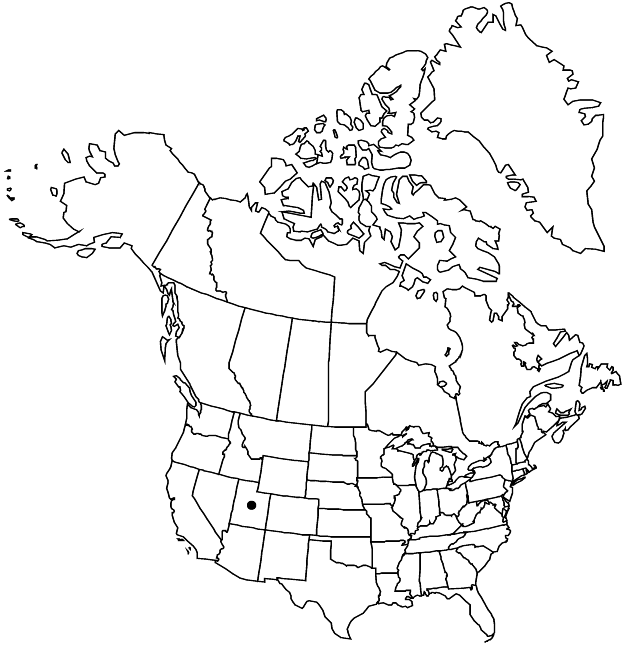Difference between revisions of "Eriogonum hylophilum"
Great Basin Naturalist 27: 190, fig. 2. 1968.
FNA>Volume Importer |
imported>Volume Importer |
||
| (4 intermediate revisions by one other user not shown) | |||
| Line 8: | Line 8: | ||
}} | }} | ||
|common_names=Gate Canyon wild buckwheat | |common_names=Gate Canyon wild buckwheat | ||
| + | |special_status={{Treatment/ID/Special_status | ||
| + | |code=E | ||
| + | |label=Endemic | ||
| + | }}{{Treatment/ID/Special_status | ||
| + | |code=C | ||
| + | |label=Conservation concern | ||
| + | }} | ||
|basionyms= | |basionyms= | ||
|synonyms={{Treatment/ID/Synonym | |synonyms={{Treatment/ID/Synonym | ||
|name=Eriogonum corymbosum var. hylophilum | |name=Eriogonum corymbosum var. hylophilum | ||
|authority=(Reveal & Brotherson) S. L. Welsh | |authority=(Reveal & Brotherson) S. L. Welsh | ||
| + | |rank=variety | ||
}} | }} | ||
|hierarchy=Polygonaceae;Polygonaceae subfam. Eriogonoideae;Eriogonum;Eriogonum subg. Eucycla;Eriogonum hylophilum | |hierarchy=Polygonaceae;Polygonaceae subfam. Eriogonoideae;Eriogonum;Eriogonum subg. Eucycla;Eriogonum hylophilum | ||
| Line 37: | Line 45: | ||
-->{{#Taxon: | -->{{#Taxon: | ||
name=Eriogonum hylophilum | name=Eriogonum hylophilum | ||
| − | |||
|authority=Reveal & Brotherson | |authority=Reveal & Brotherson | ||
|rank=species | |rank=species | ||
| Line 51: | Line 58: | ||
|publication title=Great Basin Naturalist | |publication title=Great Basin Naturalist | ||
|publication year=1968 | |publication year=1968 | ||
| − | |special status= | + | |special status=Endemic;Conservation concern |
| − | |source xml=https:// | + | |source xml=https://bitbucket.org/aafc-mbb/fna-data-curation/src/2e0870ddd59836b60bcf96646a41e87ea5a5943a/coarse_grained_fna_xml/V5/V5_487.xml |
|subfamily=Polygonaceae subfam. Eriogonoideae | |subfamily=Polygonaceae subfam. Eriogonoideae | ||
|genus=Eriogonum | |genus=Eriogonum | ||
Latest revision as of 22:11, 5 November 2020
Subshrubs, spreading, not scapose, 2.5–4 × 3–5 dm, tomentose, greenish. Stems spreading, often with persistent leaf bases, up to 1/4 or more height of plant; caudex stems somewhat matted; aerial flowering stems erect or nearly so, somewhat stout, solid, not fistulose, 0.5–1.5 dm, tomentose. Leaves cauline and sheathing proximal 1/3 of stem, 1 per node; petiole 0.5–1(–1.8) cm, tomentose; blade linear-lanceolate to lanceolate, 3.5–7(–9) × 0.3–0.6(–0.8) cm, densely white-tomentose abaxially, less so and greenish adaxially, margins plane and slightly revolute, rarely crenulate. Inflorescences cymose, open, 3–8 × 3–10 cm; branches dichotomous, tomentose; bracts 3, scalelike, triangular, and 2–3 mm, or leaflike, 1–2 cm, and similar to leaf blades. Peduncles absent. Involucres 1 per node or 2–3 per cluster, turbinate, 3.5–4 × 2.5–3 mm; teeth 5–6, erect, 0.5–1 mm. Flowers (3–)3.5–4(–4.5) mm; perianth white, glabrous; tepals connate proximal 1/4, slightly dimorphic, those of outer whorl spatulate, 1-3–1.7(–2) mm wide, those of inner whorl oblanceolate, 0.6–0.9(–1.2) mm wide; stamens included, 2–3(–3.5) mm; filaments pilose proximally. Achenes brown, 2.5–3 mm, glabrous except for slightly papillate beak.
Phenology: Flowering Jul–Sep.
Habitat: Gravelly slopes, sagebrush communities, pinyon-juniper or montane conifer woodlands
Elevation: 2200-2600 m
Discussion
Of conservation concern.
Eriogonum hylophilum is known from a few, scattered locations in the Gate Canyon area and just west along the rim of the Badland Cliffs in Duchesne County. The species is closely related to E. corymbosum and approaches the minor segregate of the latter known as var. erectum. It is possible that the Gate Canyon wild buckwheat has an evolutionary history involving that expression of E. corymbosum and the white- to cream-colored flower expression of E. brevicaule var. laxifolium. If so, E. hylophilum is a stable and persistent taxon of hybrid origin.
Selected References
None.
